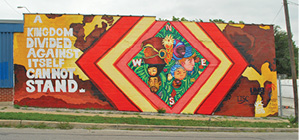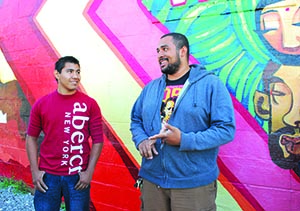
By LESLIE COLLINS
Northeast News
October 2, 2013
Gang related tags in Historic Northeast continue to plague businesses and homes, but the city of Kansas City is hoping to thwart gang graffiti through several new initiatives, including its Spirit of Community mural program.
“It’s a great frustration many businesses have,” City Council member Scott Wagner said of graffiti. “They clean it up and then it gets tagged again.”
One building that became a frequent target is located at the corner of Independence and Norton Avenues. Instead of gang tags, however, the building now sports a new mural, thanks to the Spirit of Community mural program, which is run by the city’s Gateway Crimes Task Force. The Northeast business was chosen as the first to benefit from the new program and to celebrate, a mural unveiling ceremony was held Sept. 24.
“Many would say it’s a mural. What’s the big deal?” Wagner said. “We are really taking something that many see as a nuisance (tagging) and together we’re saying we can do something about it. I look at this not as an ending but as a beginning to something much greater.”
Several organizations partnered together to make the mural possible, which include the Municipal Art Commission, Greater Kansas City Local Initiatives Support Corporation (LISC), Mattie Rhodes Center, United Missouri Bank (UMB) and the Kansas City Atheist Coalition.
“The title of the mural, ‘A Kingdom Divided Against Itself Cannot Stand,’ is a reminder to us, the community, that if we cease to work together, then we’re forever doomed to live in a broken state, in constant need of repair,” said John “JT” Daniels, a professional artist who oversaw the mural project.
Daniels worked on the mural with two other youth (Megan Dux and Sergio Ortiz Vieyra) and they took the theme of Spirit of Community to heart. Historic Northeast is a melting pot, he said, and they viewed the residents as ambassadors of their native country who were living in a new kingdom.
“In order to have a proper kingdom, you have to be united,” he said. “Working together is the best way to stand.”
For two-and-a-half months, the group of three worked on the mural for hours on end and created a mural that represents diversity, showcasing the different faces of Northeast. In the background is a world map and next to the faces of Northeast are “strands” which represent “strands of fate” and how all of our story lines are interconnected, he said.
During the process, the team faced a hiccup when vandals stole a significant amount of paint slated for the mural as well as a city power washer.
As a result, the team took a week-long break, but when word spread about the theft, UMB donated $800 to replace the paint and the power washer.
“We were glad we were able to participate with this,” said UMB Northeast branch President Jon Henderson. “We’re very interested in youth and the arts.”
For LISC, funding the mural project is two-fold.
“We’re excited for a couple of reasons,” said Micah Kubic, senior program officer for LISC. “One, because we know that murals help to deter graffiti; we know they get rid of those things called crime and grime and lead to better quality of life for this neighborhood as a whole. Second of all, we’re excited because we really believe in the power of art to inspire, to unite and transform a community.”
Graffiti: A gateway crime
One of the reasons the Gateway Crimes Task Force is targeting unwanted graffiti is because it’s a crime that can lead to more serious offenses, Wagner said.
Wagner recently attended a graffiti conference in Arizona and during the conference, a Phoenix police officer said 30 to 40 percent of the taggers they arrest are caught with drugs or weapons on them. Often, graffiti is tied to gang activity, Wagner said.
“You have people who want to show how tough or how important they are and they use graffiti as an outlet to do that,” he said.
For the first time, the city involved youth in the mural process, Wagner said, and involving youth is something the city would like to continue with future murals. Not only does it provide the youth with hands-on work with a professional artist, it could also lead to professional gigs down the road or simply give youth a positive outlet, he said.
To date, the Gateway Crimes Task Force has provided residents with graffiti removal training, allowed neighborhoods to borrow graffiti removal equipment and chemicals and distributed informational brochures regarding graffiti abatement.
The next phase includes introducing more aggressive city ordinances to address graffiti, placing more pressure on property owners to abate graffiti in a timely manner, and enhancing city staffing capabilities. One example is a software program that can track graffiti cases, tying them together to give prosecutors a stronger case.
“It really is a gateway to other things,” Wagner said. “So, we want to be more aggressive than we have been. We’ve made some strides, but there’s more to do.”
















